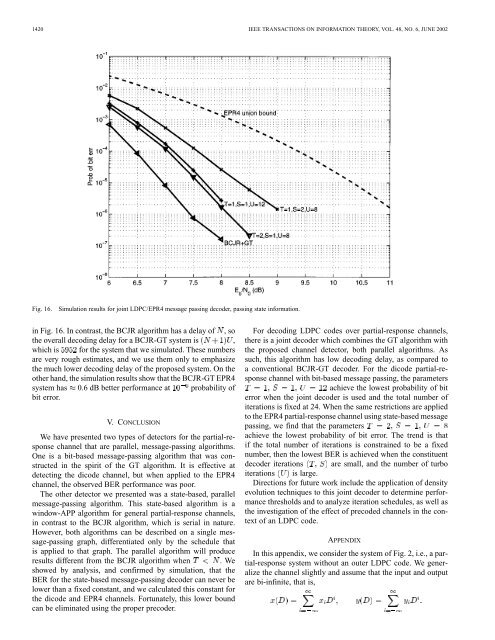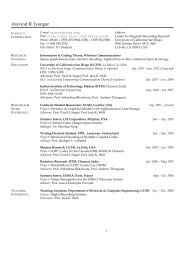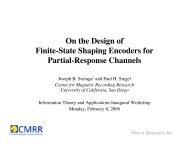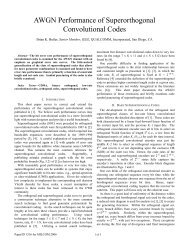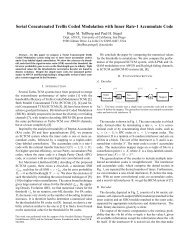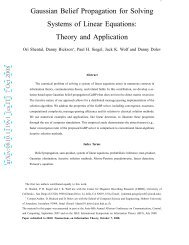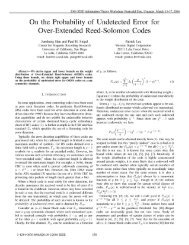Joint message-passing decoding of LDPC codes and ... - CiteSeerX
Joint message-passing decoding of LDPC codes and ... - CiteSeerX
Joint message-passing decoding of LDPC codes and ... - CiteSeerX
Create successful ePaper yourself
Turn your PDF publications into a flip-book with our unique Google optimized e-Paper software.
1420 IEEE TRANSACTIONS ON INFORMATION THEORY, VOL. 48, NO. 6, JUNE 2002<br />
Fig. 16.<br />
Simulation results for joint <strong>LDPC</strong>/EPR4 <strong>message</strong> <strong>passing</strong> decoder, <strong>passing</strong> state information.<br />
in Fig. 16. In contrast, the BCJR algorithm has a delay <strong>of</strong> ,so<br />
the overall <strong>decoding</strong> delay for a BCJR-GT system is ,<br />
which is for the system that we simulated. These numbers<br />
are very rough estimates, <strong>and</strong> we use them only to emphasize<br />
the much lower <strong>decoding</strong> delay <strong>of</strong> the proposed system. On the<br />
other h<strong>and</strong>, the simulation results show that the BCJR-GT EPR4<br />
system has 0.6 dB better performance at probability <strong>of</strong><br />
bit error.<br />
V. CONCLUSION<br />
We have presented two types <strong>of</strong> detectors for the partial-response<br />
channel that are parallel, <strong>message</strong>-<strong>passing</strong> algorithms.<br />
One is a bit-based <strong>message</strong>-<strong>passing</strong> algorithm that was constructed<br />
in the spirit <strong>of</strong> the GT algorithm. It is effective at<br />
detecting the dicode channel, but when applied to the EPR4<br />
channel, the observed BER performance was poor.<br />
The other detector we presented was a state-based, parallel<br />
<strong>message</strong>-<strong>passing</strong> algorithm. This state-based algorithm is a<br />
window-APP algorithm for general partial-response channels,<br />
in contrast to the BCJR algorithm, which is serial in nature.<br />
However, both algorithms can be described on a single <strong>message</strong>-<strong>passing</strong><br />
graph, differentiated only by the schedule that<br />
is applied to that graph. The parallel algorithm will produce<br />
results different from the BCJR algorithm when .We<br />
showed by analysis, <strong>and</strong> confirmed by simulation, that the<br />
BER for the state-based <strong>message</strong>-<strong>passing</strong> decoder can never be<br />
lower than a fixed constant, <strong>and</strong> we calculated this constant for<br />
the dicode <strong>and</strong> EPR4 channels. Fortunately, this lower bound<br />
can be eliminated using the proper precoder.<br />
For <strong>decoding</strong> <strong>LDPC</strong> <strong>codes</strong> over partial-response channels,<br />
there is a joint decoder which combines the GT algorithm with<br />
the proposed channel detector, both parallel algorithms. As<br />
such, this algorithm has low <strong>decoding</strong> delay, as compared to<br />
a conventional BCJR-GT decoder. For the dicode partial-response<br />
channel with bit-based <strong>message</strong> <strong>passing</strong>, the parameters<br />
achieve the lowest probability <strong>of</strong> bit<br />
error when the joint decoder is used <strong>and</strong> the total number <strong>of</strong><br />
iterations is fixed at 24. When the same restrictions are applied<br />
to the EPR4 partial-response channel using state-based <strong>message</strong><br />
<strong>passing</strong>, we find that the parameters<br />
achieve the lowest probability <strong>of</strong> bit error. The trend is that<br />
if the total number <strong>of</strong> iterations is constrained to be a fixed<br />
number, then the lowest BER is achieved when the constituent<br />
decoder iterations are small, <strong>and</strong> the number <strong>of</strong> turbo<br />
iterations is large.<br />
Directions for future work include the application <strong>of</strong> density<br />
evolution techniques to this joint decoder to determine performance<br />
thresholds <strong>and</strong> to analyze iteration schedules, as well as<br />
the investigation <strong>of</strong> the effect <strong>of</strong> precoded channels in the context<br />
<strong>of</strong> an <strong>LDPC</strong> code.<br />
APPENDIX<br />
In this appendix, we consider the system <strong>of</strong> Fig. 2, i.e., a partial-response<br />
system without an outer <strong>LDPC</strong> code. We generalize<br />
the channel slightly <strong>and</strong> assume that the input <strong>and</strong> output<br />
are bi-infinite, that is,


